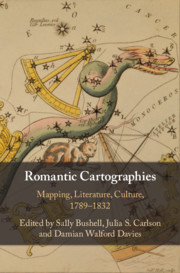Book contents
- Romantic Cartographies
- Romantic Cartographies
- Copyright page
- Contents
- Illustrations
- Notes on Contributors
- Preface
- Acknowledgements
- Introduction Romantic Cartographies
- Part I Romantic Maps, Romantic Mapping
- Chapter 1 Cartography and Natural History in Late-Eighteenth-Century Canada
- Chapter 2 ‘That Experienced Surveyor, Colonel Mudge’
- Chapter 3 The British Atlas
- Chapter 4 Mapping Invasion
- Part II Cartographic Encounters
- Part III Beyond Romantic Cartographies
- Bibliography
- Index
Chapter 2 - ‘That Experienced Surveyor, Colonel Mudge’
Romantic Representations of the Ordnance Survey Map-Maker, 1791–1830
from Part I - Romantic Maps, Romantic Mapping
Published online by Cambridge University Press: 15 January 2021
- Romantic Cartographies
- Romantic Cartographies
- Copyright page
- Contents
- Illustrations
- Notes on Contributors
- Preface
- Acknowledgements
- Introduction Romantic Cartographies
- Part I Romantic Maps, Romantic Mapping
- Chapter 1 Cartography and Natural History in Late-Eighteenth-Century Canada
- Chapter 2 ‘That Experienced Surveyor, Colonel Mudge’
- Chapter 3 The British Atlas
- Chapter 4 Mapping Invasion
- Part II Cartographic Encounters
- Part III Beyond Romantic Cartographies
- Bibliography
- Index
Summary
In June 1791, the ‘Trigonometrical Survey’ was formally established by the military’s Board of Ordnance. Enthusiasm for a comprehensive, up-to-date map of the nation had been building in military and scientific communities throughout the late eighteenth century and was catalysed by the French Revolution and the impetus to improve Britain’s coastal fortifications against invasion. Writers saw in the project an encapsulation of the Enlightenment obsession with quantification and accuracy (and their shortcomings), as well as a debate concerning the aesthetics of landscape representation. This chapter considers an aspect of the Survey’s cultural influence between 1790 and 1820: responses to its director, William Mudge. Representations of Mudge occurred in newspaper reports, early-nineteenth-century landscape poetry, and guide books. He was interpreted, variously, as an heir to the mid-eighteenth-century tradition of elevated, detached, unifying observation of landscape; an embodiment of empirical veracity; a celebration of state bureaucracy; and an example of abundant cross-fertilization between military and civilian spheres. This chapter will trace how and why such cartographical celebrities disappeared from cultural view after 1820. The resonances of Mudge’s presence in Romantic-era texts extend from what is, at first sight, a minor literary detail to illuminate major historical changes in British civilian and military culture.
- Type
- Chapter
- Information
- Romantic CartographiesMapping, Literature, Culture, 1789–1832, pp. 50 - 77Publisher: Cambridge University PressPrint publication year: 2020



